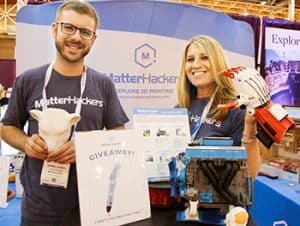
The 2018 ALA Annual Conference and Exhibition in New Orleans afforded attendees with opportunities to network with some of the 17,599 individuals who share their interest in libraries. The geography of the exhibit floor paralleled the ongoing trends in the library technology industry—consolidated companies bringing together growing portfolios of synergistic offerings, plus a rich array of smaller organizations providing boutique services and niche products. A theme of convergence prevails throughout the technology industry, where companies assemble suites of content, resource management, discovery, and workflow tools to address the expanding missions of libraries.
The conference brought together more than 750 companies and organizations in the world’s largest exhibition of library-oriented technology. This roundup describes a few of the products that caught my eye. It’s not a comprehensive report; there were just too many interesting items on hand to write about them all.
Seeking synergies

ProQuest is a good example of a large company showing convergence and synergy, with its many brands and subsidiaries united within its large island booth. Though well known for its databases, ProQuest has become the leading provider of technology to research and academic libraries through its 2015 acquisition of Ex Libris. Its Alma library services platform, used by more than 1,000 academic libraries, provides the foundation for the company’s new round of products—Leganto, which integrates library resources into learning management systems, and the Esploro research services platform. Ex Libris announced in June that it had released an early version of Esploro to its development partners, including Lancaster University and the University of Sheffield in the UK, and the University of Oklahoma, University of Miami, and the University of Iowa in the US. Other items featured at the ProQuest booth included OASIS, Syndetics Unbound, RefWorks, and Ebook Central.
EBSCO Information Services likewise promoted its broad portfolio of content and discovery products. In addition to the core EBSCOhost databases, the company featured its EBSCO Discovery Service (EDS), the Full Text Finder resource management tools, and the GOBI acquisitions platform. EBSCO’s approach to synergies between content and resource management is based on interoperability and support of open source alternatives. The company has not acquired or developed its own integrated library system (ILS) or library services platform (LSP), but it partners with dozens of other companies to integrate EDS with existing products. FOLIO, the initiative to create an open source LSP, is a prominent topic in discussions and presentations by EBSCO personnel. EBSCO has been instrumental in conceiving and providing resources for this project, with a rapidly expanding coalition of companies and libraries participating in its design, development, and advocacy. Advancing through its development phase, EBSCO is now promoting its hosting and data services for FOLIO and has announced an early set of libraries, including the University of Alabama, engaged as beta sites for its services.
The Elsevier booth reflected the company’s increasing emphasis on analytics and research workflow tools in addition to its mainstay publications and content platforms. Prominently featured products included an institutional edition of its Mendeley citation manager, Mendeley Data for the management of research data, the Scopus search engine for scientific literature, its Pure research management platform, the recently launched SciVal indicator of research impact, and the bepress institutional platform it acquired in 2017. The product focus at the Elsevier booth offered a glimpse into shifts in the business side of scholarly publishing, from subscriptions to open access and a new emphasis on involvement with the scientific research process prior to launching new publications.
Clarivate Analytics highlighted its offerings in the increasingly competitive arena of research workflow and analytical tools. In addition to its well-known Web of Science citation index, Clarivate demonstrated the Kopernio browser plug-in, acquired in April, that provides one-click access to research articles from any citation found on the web. Clarivate also featured its EndNote citation manager and its InCites research productivity benchmarking service.
Gale, a Cengage Company, has also ventured beyond its mainstay content products into the scholarly workflow and technology arena. The company has developed a Digital Scholar Lab that uses its vast body of literature as the basis for digital humanities research. The lab, now in beta test mode, facilitates humanities research and analysis without the need for researchers to develop their own technical tools. In addition to Gale content, scholars can also use its tools to process the text of other documents of interest.
OCLC’s portfolio continues to expand. Building on its core WorldCat database, OCLC delivers bibliographic and interlibrary loan services, and its WorldShare Management Services holds its own as a major competitor in the LSP arena. On the resource-sharing front, the nonprofit has launched Tipasa as the migration path for the renowned but aging ILLiad software developed by Atlas Systems and exclusively distributed by OCLC. For public libraries, OCLC launched Wise, a “patron engagement system” that blends core library management features into a patron-centric design and delivers personalized services and targeted marketing.
Follett, including its Baker & Taylor subsidiary, falls well into the cadre of supersized companies with a diverse slate of interrelated products for content, acquisition workflows, resource management, and discovery. Its Axis 360 service for delivery of digital content complements the Title Source 360 acquisitions service. Follett Destiny dominates PreK–12 school library automation, and Titlewave provides an acquisitions platform. The Baker & Taylor ESP (evidence-based selection planning) provides a data-driven approach to help libraries develop collections in line with their patrons’ interests.
Digital and physical convergence
Rakuten OverDrive had a major presence at the conference. Most public libraries in the US use OverDrive’s digital content platform for providing access to digital media. The company continues to expand internationally and into other types of libraries. In 2017, OverDrive introduced Libby, a new app for discovery and access of a library’s collection of ebooks, audiobooks, and magazines. The company reported an overwhelmingly positive reaction to the app, as seen in a 22% increase in digital use over the previous year. OverDrive offers a full set of APIs that allow library catalogs to blend the discovery of digital content and print materials.
The Bibliotheca booth showcased new products that unite physical and digital media. The company ranks as the largest global provider of RFID, self-service, and automated material-handling equipment. The 2015 acquisition of 3M Library Systems not only bolstered its position but brought it into the realm of digital lending through the cloudLibrary service. A new set of cloudLibrary modules strengthens self-service options for library patrons looking for both print and digital. A new cloudLibrary app provides self-checkout for physical materials and allows patrons to discover, download, and view ebooks.
Odilo now positions itself as a digital content service company. Products featured include OdiloTK for the management and lending of digital content; Odilo Consortia to enable groups of libraries to collaborate to acquire and share titles; and Odilo Simplicity, an online catalog for discovery and access to print and digital content that can be used in conjunction with the library’s existing ILS. The company has introduced an eBookClub that enables libraries to offer virtual book clubs with online discussions, chat messaging, and shared highlighting or commenting on content passages.
The ILS scene
At SirsiDynix, company representatives demonstrated the BLUEcloud suite of products that provide modern web interfaces and new functionality to libraries using the company’s Symphony and Horizon ILS products. A new version of BLUEcloud Mobile integrates with the Baker & Taylor Axis 360 service for discovery, access, and viewing of digital media. SirsiDynix has also launched a new Community Engagement Platform, enabling libraries to create targeted marketing and communications channels with their patrons based on usage and demographics.
The Innovative booth featured the company’s extensive line of products, including its flagship Sierra and Polaris integrated library systems, its Encore discovery interface, the VITAL digital asset management system, and its newly rebranded Resource Sharing products (formerly known as INN-Reach). The company also previewed some new efforts, powered by a context engine now under development.
The Library Corporation (TLC) featured new phases of both the CARL•X and Library.Solution ILSes. CARL•X is designed for larger library systems and was recently implemented by The Library Network in Michigan. Library•Solution has been adopted by small to midsized public libraries and school libraries. TLC also offers many other services, including the eBiblioFile MARC record service for ebook collections and RDAExpress for the conversion of bibliographic records to the RDA cataloging practice. The company has also introduced a line of SmartTECH products to help organizations create makerspaces and other interactive learning environments.
Auto-Graphics provides products primarily for public libraries, including its VERSO ILS and the SHAREit platform enabling patron-initiated borrowing for statewide initiatives and consortia. Both are based on a fully web-based platform. SHAREit was recently selected by the Reaching Across Illinois Library System consortium of 1,300 public, school, and academic libraries. Auto-Graphics has also developed the MONTAGEdc digital collection management system, implemented by Chaffey College and the City of Ontario Library in California.
Book Systems demonstrated its web-based Atriuum ILS used by small public libraries, schools, and church libraries. Atriuum can support single libraries or multibranch systems.
LibLime, a division of PTFS (Progressive Technology Federal Systems), demonstrated its web-based Bibliovation LSP, including support for GEOMARC bibliographic records with geographic data, and RDA. LibLime has recently enhanced the Discovery Layer Service for Bibliovation with new messaging options for patrons for purchase requests, holds, and interlibrary loan. The company also demonstrated its new serials control module.
Biblionix has developed its web-based Apollo ILS exclusively for small to midsized public libraries. The company recently introduced a VersaCard service that enables groups of libraries to form ad hoc consortia and enables patrons to borrow materials across participating members. This lightweight solution allows smaller libraries to share resources without the complexities inherent in larger products.

Vendors from Media Flex demonstrated OPALS, a web-based ILS designed for schools and other small libraries. It has also been adopted by many church and synagogue libraries.
Libib is a cloud-based, mobile-oriented online catalog and management system for very small or home libraries. A free version is available for collections under 5,000 items. Larger libraries can subscribe to Libib Pro, priced at $99 per year. An automatic metadata feature adds most items by simply scanning the ISBN barcode.
Patron engagement
BiblioCommons continues to expand its offerings that focus on public library patron experience. Its core product, BiblioCore, provides a discovery interface for public libraries that is enriched with a variety of personalized and social capabilities. While BiblioCore replaces the online catalog provided by the library’s ILS, BiblioWeb takes the place of a library’s entire website and is updated and configured through a console interface without the need for staff to master HTML coding or web design. Just prior to the conference, BiblioCommons announced BiblioApps, its next-generation mobile app. BiblioCore provides complete catalog functionality for both desktop and mobile devices through its responsive design. BiblioApps takes this experience further for mobile devices, using their unique capabilities to enhance the physical context for users. BiblioCommons also featured its new BiblioOmni, a marketing platform for public libraries that allows messaging through multiple communications channels. This product brings capabilities available for many years in retail businesses to libraries to help them increase community engagement.
Yewno demonstrated its visual discovery interface that is powered by a machine-learning-based search engine. The Yewno platform has ingested a growing body of scholarly and professional literature, drawing inferences and extracting insights from data, rather than indexing traditional keywords. Researchers can explore documents and create result sets based on concepts, which can span multiple languages.
Open source
Open source software represents a routine part of the library technology economy. Its business model centers on services rather than license fees. Several organizations specialize in open source hosting and support services.
ByWater Solutions is the leading provider of migration, support, and hosting services to public, school, and public libraries in the US for the open source Koha ILS. In a breakthrough into the ranks of large academic libraries, ByWater announced at the conference that it has successfully implemented Koha and the open source Coral ERM for the libraries of Virginia Tech University.
The Equinox Open Library Initiative provides services for the open source Evergreen and Koha ILSes. Equinox recently announced a new set of integration features with BookNet Canada to enable exporting data from Evergreen to let libraries take advantage of its collection management capabilities.
TIND offers services for the open source software developed at CERN and addresses many aspects of library resource management. The Caltech University library implemented the TIND ILS in 2015 and later deployed the TIND RDM to manage its research data repository. The TIND institutional repository and digital archive are also seeing increased adoption by libraries in the US and Europe.
IndexData, a relatively small software development company, has gained a high profile through its involvement with the FOLIO project. Engaged by EBSCO to develop the initial microservices platform for FOLIO, IndexData continues to be a major force in its development and promotion. At the conference, the company highlighted services it plans to offer for FOLIO, including migration, hosting, and support.
Productivity and efficiency
Another group of companies demonstrated sorting, self-service, and related equipment. These working installations of equipment set up especially for the exhibit hall were impressive. I got a quick look at the wares of Lyngsoe Systems, P.V. Supa, mk Solutions, D-Tech International, and EnvisionWare, but did not have a chance this time for in-depth demonstrations. Please check their websites for more information.
TechLogic, a wholly owned subsidiary of TLC, offers a wide array of self-service, security, and automated material handling products. The ValueIT system combines sorting technology with software to allow libraries to maximize their revenue from donated or weeded materials by identifying high-value items that can be automatically posted on e-commerce platforms such as Amazon. TechLogic also demonstrated its CircTRAK shelf manager that includes a hand-held RFID wand and software to check the status of each item with the library’s ILS as part of a continuous inventory process.
Niche players
In addition to the large companies with far-reaching product strategies, it was refreshing to see so many others displaying specialized products. They might offer only a single product or a small suite of related tools to address specific needs, and they generally embrace an entrepreneurial spirit and a more personalized approach to customer support.
Atlas Systems promoted its Aeon automated request and workflow management system. Used by special collections departments within academic libraries or archives, Aeon tracks items as they are requested for borrowing, used in-house by researchers, or dispatched for processing. Atlas Systems previously developed the ILLiad interlibrary loan management utility that has been widely adopted by libraries throughout the US and globally, distributed by OCLC.
OpenAthens offers a federated authentication service that has been implemented by 2,600 organizations in 50 countries. Its service enables an organization to offer a single sign-on that provides access to all its restricted resources.
Springshare, originally known for its LibGuides for academic disciplines, has continually expanded its platform to deliver additional types of content. The LibGuides content management system can replace a library’s website; LibAnswers supports online reference services via SMS, built-in chat, email, or social media messaging; the LibCal scheduling system can be used for reserving library study rooms or equipment; and LibWizard lets library personnel create tutorials. Springshare recently developed LibCRM to provide customer relationship management features in support of library outreach services, fundraising, or departmental liaison activities.

A variety of small companies were clustered in a section of the exhibit hall oriented to library makerspaces or innovation labs. These organizations included MatterHackers, Dynamism (offering a variety of 3D printing solutions), Ultimaker (also a 3D solutions company), and Library Trek.
Capira Technologies offers several products for libraries using mobile and digital technology to enhance patron experiences. The CapiraMobile app provides push notifications, self-checkout through patron devices, a digital library card, ISBN scanning, and iBeacon app integration; MuseumKey offers museum pass reservation software; and CapiraConnect provides interactive location-based information and push notifications.
ChiliFresh has developed a variety of content and social enhancements for library catalogs packaged into the ChiliPAC discovery interface, which returns standard catalog results as well as content from booklists, readers’ advisory lists, and patron-supplied aggregations of reviews and ratings.
StackMap offers a set of tools for dynamically generating indoor maps that can be incorporated into a library catalog to display written directions and physical locations of collection materials. The company also offers its computer availability mapping utility that displays a map of all the computers in the library that are either available for use or currently occupied.
The personal touch
Technology for libraries involves much more than products and services. Each company makes investments in personnel, including a large number of librarians, to design, build, market, and support their products. Their executives develop product and business strategies that sustain their companies in the library economy, which affords only modest opportunities relative to other business sectors. For the last few years I have organized and hosted the Library Information and Technology Association Executive Perspectives panel as a forum to flesh out timely events and industry trends.
The companies exhibiting at the ALA Annual Conference work hard to understand the needs of librarians and to communicate in ways that resonate with library missions and values. The vendor community makes investments in libraries in many ways, including their participation in the exhibits, which represents a substantial slice of conference funding. Exhibitors entice attendees to visit their booths through various giveaways, food, and drink. But the real currency of the exhibition is the engagement with current and potential customers—and the opportunity to inform the library community about the potential value of their products and services.

 MARSHALL BREEDING is an independent consultant, speaker, writer for Smart Libraries Newsletter and Library Technology Reports, and editor of the website
MARSHALL BREEDING is an independent consultant, speaker, writer for Smart Libraries Newsletter and Library Technology Reports, and editor of the website 
